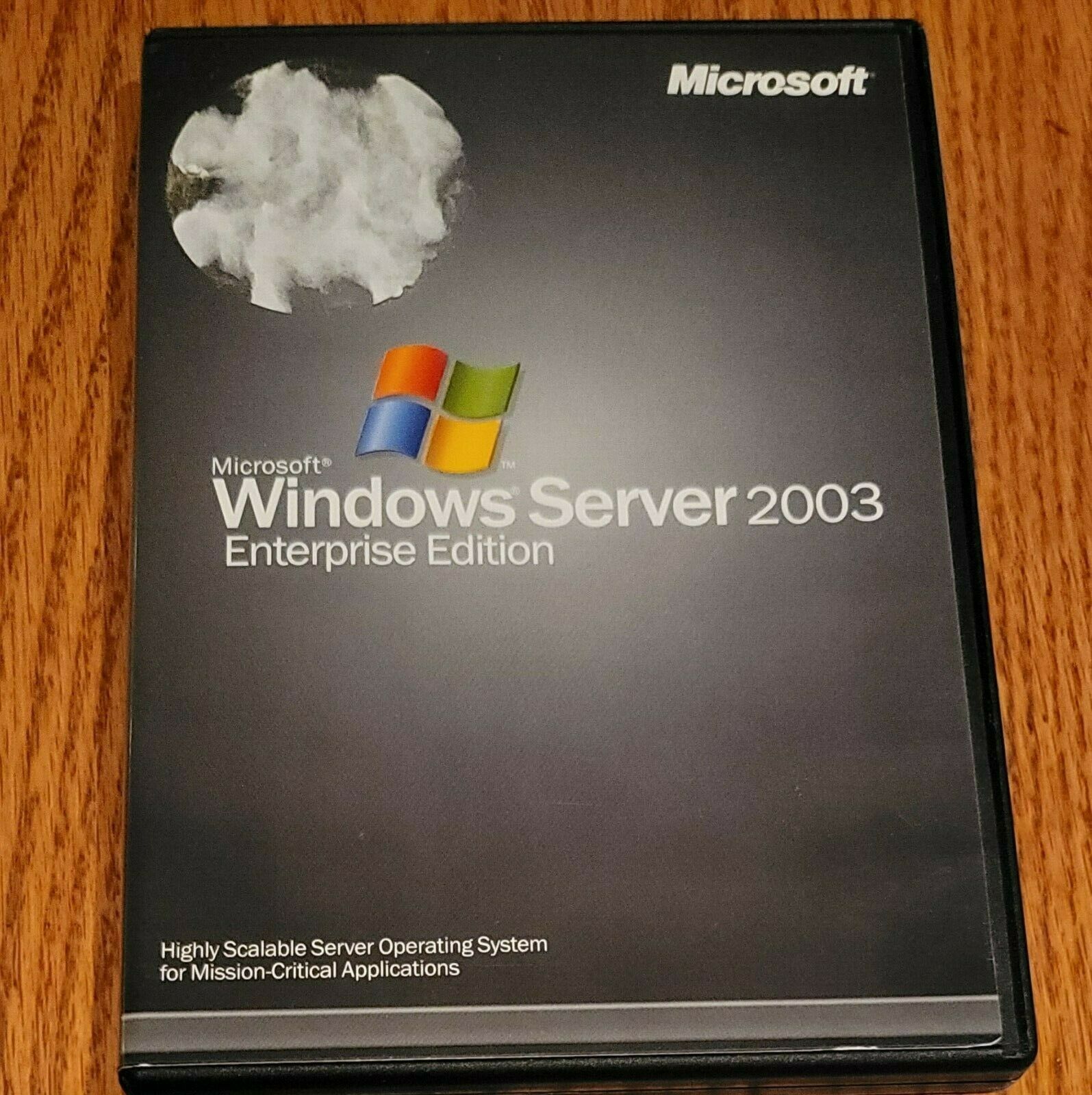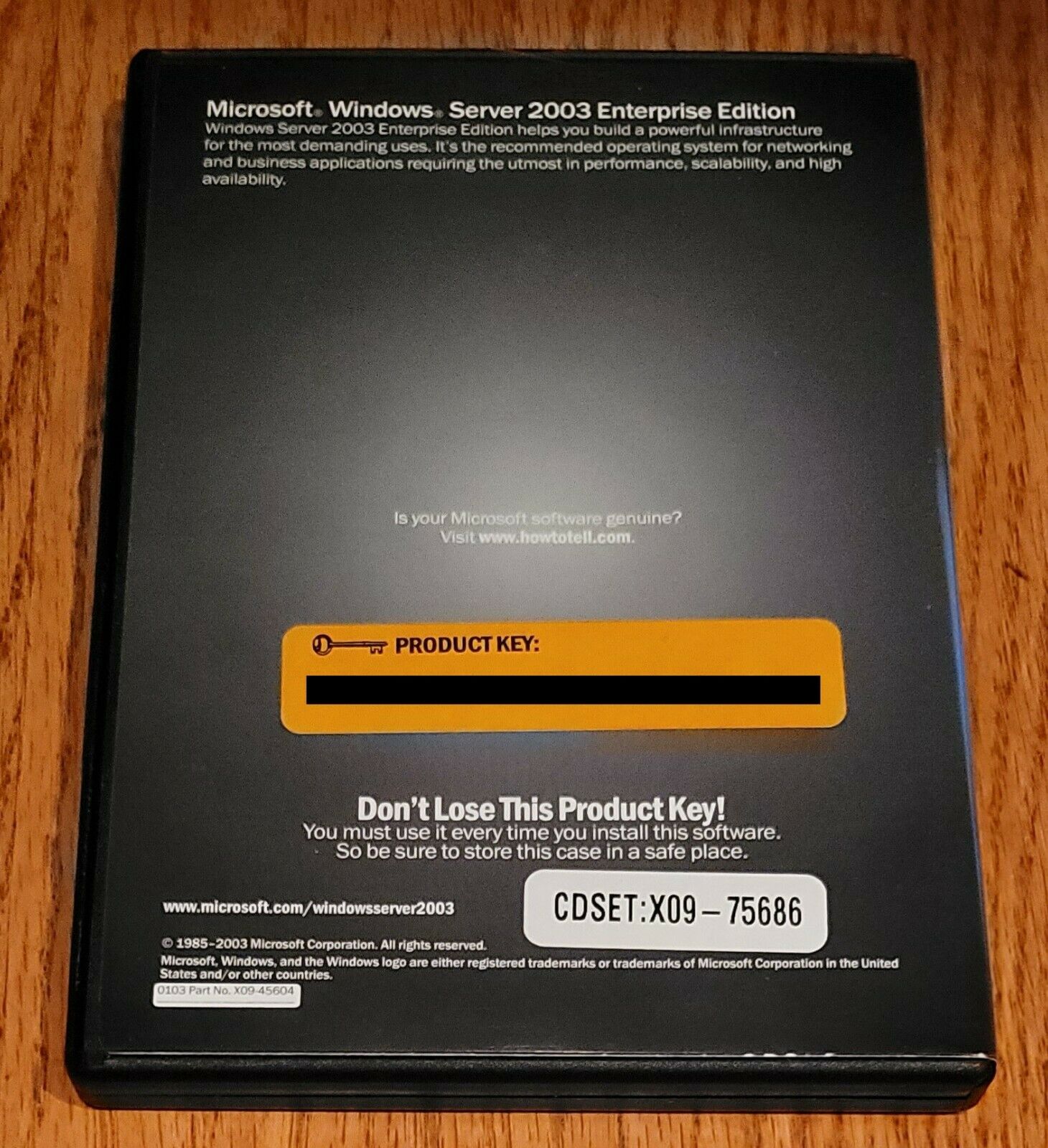-40%
Microsoft Windows Server 2003 Enterprise Edition 25 CAL P72-00818 FREE SHIPPING
$ 10.53
- Description
- Size Guide
Description
Microsoft Windows Server 2003 Enterprise Edition w/25 CalsFREE SHIPPING! WHAT A DEAL!
Comes with Windows System Resource Manager DVD, Product Key, and COA
. No retail box provided.
Bid with confidence! My 100% E-Bay rating shows I always deliver what is promised.
The description below is from 2003 so step back in time when you read it :)
In This Edition
Windows Server 2003, Enterprise Edition, differs from Windows Server 2003, Standard Edition, primarily in its support for high-performance servers and its ability to cluster servers for greater load handling. These capabilities provide reliability that helps ensure systems remain available even if problems arise.
At a high level, Windows Server 2003, Enterprise Edition, provides support for:
Eight-way symmetric multiprocessing (SMP).
To increase server performance and capacity, you can add processors, an approach to increasing your network capacity is known as scaling up. The enhanced support for SMP allows you to add processors that work together—that is, multiprocessor servers. Up to 8 multiprocessors are supported in the 32-bit version. For 64-bit Intel Itanium-based systems, 64-way SMP is supported.
Eight-node clustering.
Server clusters up to eight nodes are available only in Windows 2003, Enterprise Edition, and Windows 2003, Datacenter Edition.
32 gigabytes (GB) of RAM in 32-bit versions, 512 GB in 64-bit versions.
By adding memory, a computer can work with more information at once. Windows Server 2003, Enterprise Edition, includes enhanced memory capabilities that let you increase the memory available for server processing to as much as 32 GB of RAM in 32-bit versions and 512 GB of RAM in Itanium-based 64-bit versions.
Built for Dependability
Run Your Business on the Most Solid Server Operating System Microsoft Has Ever Released
Today’s businesses expect technology to be a consistent enabler of business value. They want systems that are always up and always responsive, and they demand a level of security able to meet today’s challenges.
Windows Server 2003, Enterprise Edition, includes new features and improvements that render it the most dependable, enterprise-ready server operating system Microsoft has ever created. Key technologies introduced in Windows 2000 Server have been enhanced, including network load balancing, server clusters, and the Active Directory® service. Active Directory is now faster and more robust over unreliable wide area network (WAN) connections, thanks to more efficient synchronization and replication as well as credential caching in branch office domain controllers.
In addition, Windows Server 2003, Enterprise Edition, introduces new technologies, such as a common language runtime that safeguards networks from malicious or poorly designed code. Moreover, the operating system reflects the Microsoft commitment to trustworthy computing, with leaps forward in security functionality, including improved security for Internet Information Services (IIS), public key infrastructure (PKI), and Kerberos, as well as new support for smart cards and biometrics.
Built for Productivity
Improve IT Effectiveness and Employee Communication and Collaboration Across Your Business
Organizations look to computing technology to improve productivity across their businesses, from information workers who want powerful tools that are easier to use to administrators who want services that are quicker to deploy and easier and more flexible to manage.
Windows Server 2003, Enterprise Edition, and other members of the Windows Server 2003 family share many features that help make your organization and employees more productive. The Windows Server 2003 family enables greater productivity for both IT administrators and users through its enhanced capabilities in system management and storage. Microsoft has made great strides in evolving manageability. The new task-based design in the Windows Server 2003 family makes it easier to find and carry out common tasks. Improvements to the Microsoft Management Console (MMC) and Active Directory improve performance and make management easier.
The Windows Server 2003 family contains several important new automated management tools including Microsoft Software Update Services (SUS) and server configuration wizards to help automate deployment. Managing Group Policy is made easier with the new Group Policy Management Console (GPMC), enabling more organizations to better use Active Directory and take advantage of its powerful cost-saving features. In addition, command-line tools let administrators perform most tasks from the command console.
Other new management and administration features in the Windows Server 2003 family include domain renaming, cross-domain and cross-forest management, and Resultant Set of Policy (RSoP) settings. Enhanced Windows Management Instrumentation (WMI) providers and command-line tools give administrators greater granular control of server tasks.
Windows Server 2003 also makes storage and backup easier while significantly reducing the demands on system administrators. New and improved file services include the Volume Copy Shadow Service, which provides point-in-time backups of networked shares. This unique technology extends to users, who can now retrieve old copies of files or deleted files. In addition, file and print services have been improved with the addition of the Web-based Distributed Authoring and Versioning (WebDAV) remote document sharing technology. Enhancements to the Distributed File System (DFS) and Encrypting File System (EFS) allow for powerful, flexible file sharing and storage. Support for 64-bit printing and print clusters has also been added in Windows Server 2003, Enterprise Edition.
To support processor- and memory-intensive applications, Windows Server 2003, Enterprise Edition, supports 64-bit computing on certified hardware platforms, including support for the Intel Itanium and Itanium2 processors.
Built for a Connected World
Securely Connect with Your Customers
Today’s networks are connecting intranets, extranets, and the Web. More and more companies are using the Internet to communicate with their customers and partners everyday. Windows Server 2003, Enterprise Edition, and other members of the Windows Server 2003 family share many features that help your organization and employees stay connected.
Networking improvements and new features in the Windows Server 2003 family extend the versatility, manageability, and dependability of network infrastructures. The Windows Server 2003 family makes it easier than ever for users to stay connected to network resources from anywhere and on any device. To make this possible, Microsoft has built significant networking enhancements in Windows Server 2003, including Internet Protocol version 6 (IPv6), Point-to-Point Protocol over Ethernet (PPoE), and Internet Protocol Security (IPSec) over network address translation (NAT).
Microsoft Windows Media® Services in the Windows Server 2003 family provide a reliable, scalable means to deliver and manage dynamic content quickly and in a cost-effective way. Windows Media Services make the Windows Server 2003 family an ideal platform for distributing streaming audio and video over corporate intranets and the Internet.
Optimized, native support of Microsoft® .NET and XML in Windows Server 2003 provides the ideal platform to develop, distribute, and host XML Web services created with the .NET Framework.
Built for Best Economics
Maximize Business Value by Leveraging the Largest Partner Solution Ecosystem
PC technology provides the most cost-effective chip platform, a considerable economic incentive for adopting Windows Server 2003. But that is only the beginning of the story. Windows Server 2003, Enterprise Edition, is a cost-efficient choice for both scale-up or scale-out purposes. With multiple essential services and components already included in Windows Server 2003, organizations can quickly benefit from an integrated platform that is easy to deploy, manage, and use.
When you adopt Windows Server 2003, you become a part of the global network that has helped make the Windows platform so productive.
This network of global services and support provides the following benefits:
Extensive ISV ecosystem.
Microsoft software has a huge number of independent software vendors (ISVs) worldwide who support Microsoft applications and build certified custom applications on the Windows platform.
Worldwide services.
Microsoft is supported by over 450,000 Microsoft Certified Systems Engineers (MCSEs) worldwide, plus vendors and partners.
Training options.
Microsoft offers a wide range of IT training, enabling IT staff to continue developing their skills at a reasonable price.
Certified solutions.
Windows has thousands of certified hardware drivers and software applications from third-party ISVs, making it easy to add new devices and applications. In addition, prescriptive guidance from Microsoft Solutions Offerings (MSOs) helps organizations build proven solutions that help solve difficult business challenges.
This ecosystem of products and services reduces total cost of ownership (TCO), helping your organization be more productive and efficient.
XML Web Services and .NET
Microsoft .NET is deeply integrated into the Windows Server 2003 family. It enables an unprecedented level of software integration using XML Web services, those discrete, building-block applications that connect to each other—as well as to other, larger applications—via the Internet.
Integral to the Microsoft platform, the .NET Framework provides the ability to quickly and reliably build, host, deploy, and use secure and connected solutions through XML Web services. The Microsoft platform provides a suite of developer tools, client applications, XML Web services, and servers necessary to participate in this connected world.
These XML Web services provide reusable components built on industry standards that invoke capabilities from other applications independent of the way the applications were built, their operating system or platform, or the devices used to access them.
With XML Web services, developers can integrate applications inside enterprises and across network boundaries with partners and customers. This advance in computing—opening the door to federated collaboration and more efficient business-to-business and business-to-consumer services—can have a significant potential impact on revenue. Millions of others can use these components in varied combinations to produce highly personal, intelligent computing experiences.
Other .NET benefits in the Windows Server 2003 family help application developers to:
Leverage their existing investments. Existing Windows–based applications continue to run on Windows Server 2003 and can be easily repackaged as XML Web services.
Write less code and use the programming languages and tools they know. This is made possible by the application services built into Windows Server 2003, such as ASP.NET, transaction monitoring, message queuing, and data access.
Use process monitoring, recycling, and built-in instrumentation to provide reliability, availability, and scalability for their applications.
All of these benefits are in the improved Windows Server 2003 application platform.
Key Features
In addition to including all the features in Windows Server 2003, Standard Edition, Windows Server 2003, Enterprise Edition, adds enhanced availability, scalability, and dependability—features also in Windows Server 2003, Datacenter Edition.
Cluster service.
Server clusters provide high availability and disaster tolerance for mission-critical database management, file sharing, intranet data sharing, messaging, and general business applications. With Windows Server 2003, Enterprise Edition, and Windows Server 2003, Datacenter Edition, cluster service supports up to eight-node clusters for increased flexibility in adding and removing hardware in a geographically dispersed cluster environment. The cluster service also provides improved scaling options for applications. Windows Server 2003, Enterprise Edition, allows server clusters to be deployed in a variety of different configurations, in particular:
Single cluster configurations with dedicated storage.
Multiple clusters on a storage area network (SAN), potentially with other Windows–based servers or operating systems.
Clusters spanning multiple sites (that is, geographically dispersed clusters).
64-bit support.
Windows Server 2003, Enterprise Edition, is available in both 32-bit and 64-bit versions. The 64-bit version is optimized for intensive memory or computational tasks, such as mechanical design, computer-aided design (CAD), professional graphics, high-end database systems, and scientific applications.
Multiprocessor support.
The Windows Server 2003 family scales from single-processor solutions all the way up to 32-way systems. Windows Server 2003, Enterprise Edition, supports servers with up to 8 processors, and Windows Server 2003, Datacenter Edition, supports up to 32 processors.
Metadirectory Services support.
Microsoft Metadirectory Services (MMS) helps organizations integrate identity information from multiple directories, databases, and files with Active Directory. MMS provides a unified view of identity information, enables the integration of business processes with MMS, and helps synchronize identity information across an organization.
Hot Add Memory.
Hot Add Memory allows ranges of memory to be added to a computer and made available to the operating system and applications as part of the normal memory pool. No rebooting and no downtime are required. This feature currently operates only on servers that have hardware support for adding memory while the server is operating. For these servers, the act of installing memory automatically invokes the Hot Add Memory feature in Windows Server 2003, Enterprise Edition.
Non-Uniform Memory Access (NUMA).
System firmware can create a table called the Static Resource Affinity Table that describes the NUMA topology of the system. Windows Server 2003, Enterprise Edition, uses this table to apply NUMA awareness to application processes, thread default affinity settings, thread scheduling, and memory management features. Additionally, the topology information is made available to applications using a set of NUMA application programming interfaces.
Terminal Services session directory.
This load balancing feature allows users to reconnect easily to a disconnected session on a server farm running Terminal Services. Session directory is compatible with the Windows Server 2003 load balancing service and is supported by third-party external load balancer products.
Windows System Resource Manager.
A feature in both Windows Server 2003, Enterprise Edition, and Windows Server 2003, Datacenter Edition, the Windows System Resource Manager (WSRM) enables an administrator to allocate CPU and memory utilization on a per-application basis. This is a useful tool for server consolidation.
Summary
With Windows Server 2003, Enterprise Edition, organizations can deploy highly available and scalable applications on industry-standard PC hardware. The result is a highly productive infrastructure optimized for running all your business-critical applications and services. For example, Windows Server 2003, Enterprise Edition, excels at supporting networking, messaging, inventory and customer service systems; databases; e-commerce Web sites; and file and print servers.
For growing organizations, the ability to scale critical applications both up and out allows them to meet changing demands. Regardless of the size of your organization, Windows Server 2003, Enterprise Edition, is a good choice for running applications that must be available at all times.












